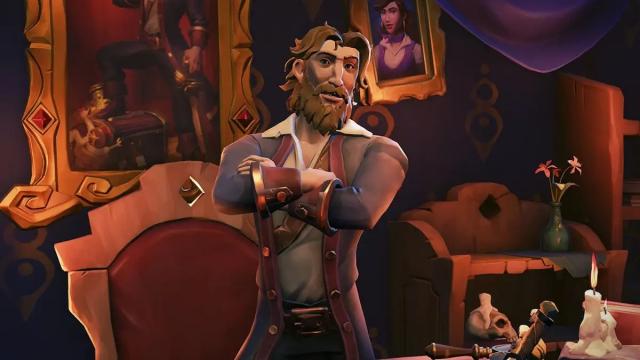
To sound like a broken record, the world-building built from A Pirate’s Life is basically Xeroxed here. More than being a transitory respawning area aboard The Ferryman’s ship, The Sea of the Damned is treated like a magical tether that teleports your crew away from the swashbuckling PvPvE shared world – so as to completely avoid any interruptions by potential adversaries. Despite trying to navigate it to visit The Sea of Thieves, somehow Guybrush & now-wife Elaine wound up back on Mêlée Island; stranger yet, virtually everyone in town is endlessly vaunting him like beloved royalty.
In lieu of Guybrush being the suspiciously-cherished Governor of Mêlée, you (and your potential party members) are essentially treated as the new pirate wannabes. You’re following a similar beat-for-beat recreation of the original Monkey Island. The good ‘ole Scumm Bar with the three important pirates, the rapscallion endlessly spinning on the chandelier, the goofy LUMO™ cross-promotion, and other faithful nuggets are so comfortably suffused that it feels like a natural extension of the SoT universe. Again, as with A Pirate’s Life, a huge part of Legend’s success comes back to faithfulness to the source material.
This appreciation can be felt through its disparities too. Instead of emulating moving dioramas and a type of “movie mentality” in structure, Legend strives to maintain nettlesome old-school adventuring across both mainline and secondary questlines. It’s funny to think about with regards to age demographics of the average SoT player; in fact, I could intuit another player’s patience wearing thin given the heavier emphasis on dialogue and back-tracking typical for these types of puzzles. I can emphasize with disliking this approach, but it’s tough to fault Rare for fastidiously respecting the original design ethos – to some extent.
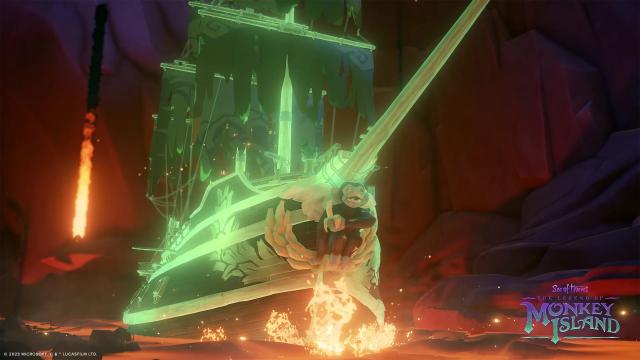
Considering how even the lesser Monkey Island entries are more consistent than Disney’s Pirates filmography, Rare had bigger story shoes to fill for this crossover. Both with regards to its source and the SoT universe, there is some copy/pasting going on. “Hmm… this ‘Sea of Thieves’ you speak of could use an omnipotent Pirate Lord to rule with an iron fist!” Then again, it’s not like anyone expects incredibly nuanced motives in these scenarios; the allure of great fortune and power has always been a staple for these adventure serials.
LeChuck’s skullduggery is quite straightforward, but I don’t remember the last time I thwarted enemies with root beer. That’s the key takeaway: it’s less about the narrative beats, and more how the story is told. The ways in which this universe has invaded Mêlée Island and tweaked certain plot points does enough legwork to feel refreshing. Even subtle additions like Elaine’s scattered journals detailing her off-screen struggles and special sitting spots for Guybrush’s narrated memoir entries always felt like nice treats. The storytelling is also sold by its humor and voice acting. Even for clumsier new lines, Dominic Armato perfectly inhabits the world’s most pleasant pirate with such ease; not to be outdone, that praise extends to the rest of the cast too, both new and returning faces.
Part of your appreciation towards the narrative, from big to granular details, will rely on nostalgia. For example, it’s inherently funnier to think about Stan the Salesman continually flailing his arms about in a 3D space when that was clearly done in the original as a means of emphasis and salesmanship. Those little things might be lost on newcomers, but that doesn’t discount the profusion of jokes that land. It’s overall not the most expansive Tall Tale, but it may be the most endearing.
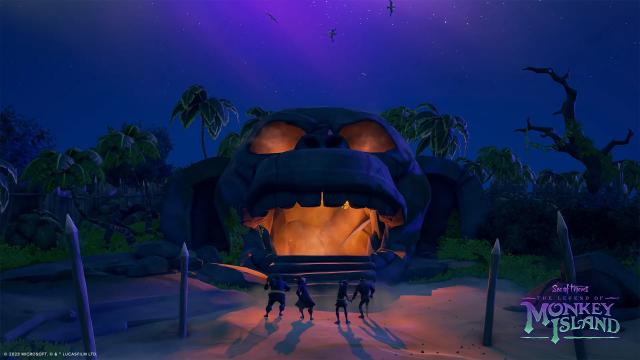
The biggest diversion from its expansion precursor is its more conservative approach to gameplay. There aren’t wider ripple effects like brand-new enemy types. As stated, the appeal comes back to its roots in adventuring. Whereas A Pirate’s Tale would emphasize a linear means of progressing – i.e. pulley puzzles, reading maps that progressively reveal more clues, etc. – Legend is more focused on each important spot and then working out which items go where. In some instances, it’d almost be tempting to have detailed quest markers or highlighted objects as a means of streamlining. I’m glad Rare avoided that and instead emphasized more in-game means of discovery, like broad hints in your quest journal.
Not all templates are created equal though. Perhaps the most disappointing feature is screwing up insult sword-fighting. It sounds easy on paper: get a few swings in and either hurl a goofy insult or counter with a witty retort; winner depends entirely on the right rejoinder. Decades on and it’s still such a fun concept. But the execution is let down by sword strikes oftentimes feeling mismatched and the awkward mini-pauses before either you or your enemy can begin an insult. Even the amount of hits needed to begin insults doesn’t match the melee’s 1-2-3 combo. It’s so kinaethstically underwhelming that they should’ve been unplayable, lavishly-animated cut scenes with dialogue options sprinkled in between. Given how you’re locked to one foe at a time, it’s not like you’re losing much opportunity for player expression anyways.
Although I respect Rare’s impetus to transplant everything about Monkey Island’s layout to an explorable 3D world – with its great art design no less – there are still some nagging quibbles that diminished its effect. For starters, it would’ve benefitted from strategic reductions in size, mostly the dead air between hot spots. This’ll be quickly felt if striving for 100% commendations (main & side quests), since Book 1 requires hauling a skeleton head up to Lookout Point and beyond to unlock. And that’s not the only secondary collect-a-thon to wrestle with either. Although having buddies will offload some of these demands, story points can be inconsistent with regards to subtitles. There’s a bit of messiness in everyone following the story together if you don’t stick in a tight group. None of these irrevocably tarnishes its overall reputation – and its launch is more polished than A Pirate’s Life – but it’s still annoying nonetheless.
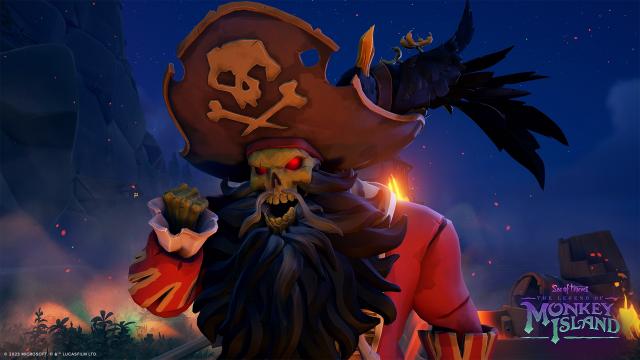
Although a broader issue with Sea of Thieves as a whole, I hate to see bloated prices for most Monkey Island-themed cosmetics. This isn’t to ignore appeals about how the sausage is made either; after all, a free expansion with a runtime of 4+ hours (more for completionists) can’t just materialize without concomitant trade-offs. Even when making reasonable concessions, it’s still annoying to see so many sparkling baubles behind this high of a paywall. Maybe it’s too fitting that one of the most successful Games-as-a-Service (GaaS) titles out there is all about thieving, looting, & pillaging to your heart’s content! Who’s to say Microsoft can’t be the real Pirate Lord, eh?
To make one last (I promise!) comparison to A Pirate’s Life: The Legend of Monkey Island is a more-polished but less-ambitious expansion. There aren’t wild ripple effects that’ll fundamentally alter the main game as you know it; that said, I don’t think it’s fair to expect that for every crossover with different priorities. Even when respecting that intent, some of Rare’s design limits its greater potential and value. Sometimes the waters get choppy, but it nevertheless succeeds in reverently capturing the spirit and mood of a bygone adventuring era.
This review is based on a digital copy of Sea of Thieves: The Legend of Monkey Island for the XS
>>> Read full article>>>
Copyright for syndicated content belongs to the linked Source : VGChartz – https://www.vgchartz.com/article/458854/sea-of-thieves-the-legend-of-monkey-island-xs/






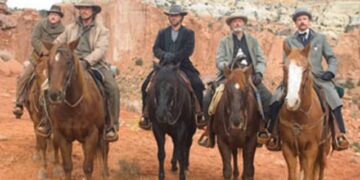







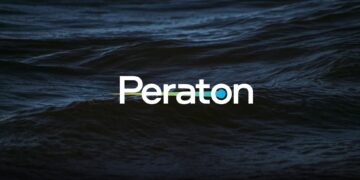
![[News] China Makes Breakthrough in Chip Technology, Paving the Way for Lithography Advancements – TrendForce](https://earth-news.info/wp-content/uploads/2025/11/324664-news-china-makes-breakthrough-in-chip-technology-paving-the-way-for-lithography-advancements-trendforce-360x180.jpg)













